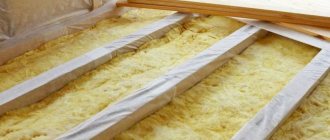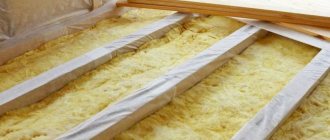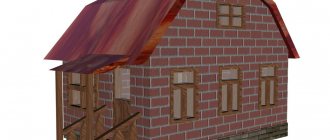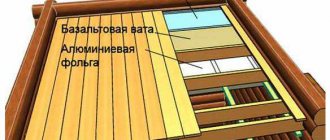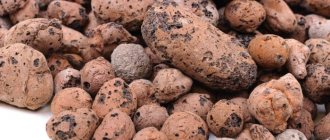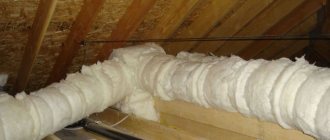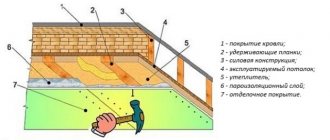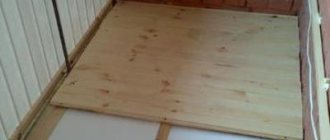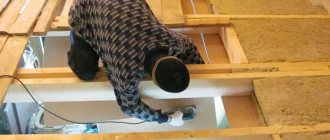Arrangement of the attic
The roof of the finished attic has the appearance of a layer cake. Exterior covering is a roofing material designed to protect a home from precipitation. From the point of view of thermal insulation, it does not provide any effect. The top waterproofing barrier is roofing material or a special film that is capable of retaining water, but is vapor permeable. It is laid in such a way that water flows through it to the outside. Next comes a layer of insulation, which forms a thermal insulation barrier.
The vapor barrier is designed to completely protect the installed insulation layer from moisture and steam. This polyethylene film is truly completely vapor and waterproof. Everything ends with a decorative coating to give aesthetic appeal and protection from mechanical damage.
The greatest difficulty in insulating an attic space is installing a waterproofing layer on insulation of a complex shape. The difficulty lies in bypassing all the load-bearing elements of the roof and organizing its exit under the roof to discharge water
It is very important here to maintain the integrity of the layer. Joints and fastening points must be taped, and secured between the rafters with staples or vertically nailed slats
The insulation is placed tightly between the rafters and, together with the hydrobarrier, is secured with slats, which will later serve as a support for the finishing. It is recommended to insulate with mineral wool formed into sheets or slabs, since it is more resistant to caking and shedding during operation compared to rolled wool.
Attic wall insulation technology
Depending on the material of the walls, there are different ways to carry out thermal insulation measures with your own hands. The most common ones are listed below:
- construction of multi-layer brick walls;
- wet facade technology;
- ventilated facades.
All these options involve external insulation. If necessary, the material can be secured from the inside, but this is less effective and can lead to greater costs.
Multilayer walls
With this method of construction, a layer of insulation is laid between the outer and inner versts, due to which the walls of the entire building, including the attic (attic), are thermally insulated.
It is important to prevent the risk of material subsidence, otherwise a “bare” area will appear in the attic
Wet facade technology
In this case, the insulation is attached to the wall with your own hands and covered with plaster on top. For durable materials, the layer of plaster mortar can be 20 mm. If it is necessary to prevent damage to the heat insulator, apply a 40 mm layer of plaster over the reinforcing mesh. This insulation option is quite simple, but does not provide reliable protection for the heat-insulating layer.
Ventilated facades
In this case, the heat insulator is attached to the wall, and the facade finishing is hung on top. An air-ventilated layer is installed between the insulation layer and the decorative layer to remove condensation. Mineral wool materials are used for this type of construction; for expanded polystyrene and foam, the technology may be the same, but they do not require a layer of air. Do-it-yourself finishing can be done with siding, hanging panels, porcelain tiles, and wood.
Insulating the attic floor with mineral wool
This modern and popular insulation is produced in rolls or mats. Mineral wool does not burn, does not rot, and is not dangerous for various microorganisms and rodents.
Insulation of the attic floor with mineral wool is carried out in stages:
- First, lay the lining material on the floor. In the case of an economical option, inexpensive glassine is laid on the ceiling. More expensive and of higher quality will be the installation of a flooring made from a vapor barrier film, which is mounted with an overlap.
- The joints of the segments are glued with tape or fastened with wooden slats, fixing them with a stapler.
- The width of the thermal insulation material is selected taking into account technical standards for a particular region. The mineral wool is laid tightly between the joists, leaving no gaps. Scotch tape is used to seal the joints.
- After laying the insulation is completed, level boards are placed on the joists and thus form the floor in the attic.
The above-described solution for how to insulate the attic of a private house with mineral wool gives the material the opportunity to “breathe” and ventilate when moisture gets on it. To prevent moisture from penetrating into the insulation, waterproofing is installed under the roof.
Insulating the attic: mandatory preparatory measures
The procedure for arranging the thermal insulation layer depends on the selected material. However, in any case, before insulating the attic, a number of mandatory measures should be taken:
- Check the condition of the old thermal insulation (if any). Moldy or rotten insulation must be disposed of. Disinfect the attic space with an antifungal compound.
- Inspect the rafters, ceiling and gable for cracks. Repair any identified damage (cracks, chips). If the defects are significant, then it is recommended to completely replace some structural elements.
- The gaps between the ceilings can be sealed with sealant, polyurethane foam or tow soaked in lime mortar.
- Treat wooden elements with a fire retardant.
- Check the condition of the ventilation system. If the ventilation of the under-roof space is insufficient and condensation accumulates on the ceiling, then the construction of additional ventilation ducts will be necessary.
Insulating an attic in a private house: step-by-step instructions
To insulate an attic space with mineral wool, you should prepare the following materials and tools:
- mineral wool;
- mounting stapler and staples;
- polyurethane foam;
- construction knife and tape;
- waterproofing film;
- personal protective equipment for hands and eyes;
- glue for mineral wool.
Preliminary activities:
- measure the insulated area - multiply the width of the surface by the length;
- determine the number of layers of mineral wool - for the central part of the Russian Federation, the insulation layer in the attic should be at least 20 cm;
- empty the attic of unnecessary items, remove debris and cobwebs;
- provide good lighting and lift the necessary tools/materials into the attic;
- Cover the floor joists with sheets of plywood - for ease of work.
The procedure for insulating with mineral wool:
- Installation of ventilation ducts is carried out in a cold attic. Special ventilation gutters are fixed under the roof with brackets. If the attic space is to be converted into a living room, then there is no need to install such gutters.
- Arrangement of waterproofing that will protect mineral wool from moisture. Stretch the film over the rafter structure, leaving small overlaps. Secure the film waterproofing with a mounting stapler.
- Placement of mineral wool. Laying is done from bottom to top:
- Apply glue to the mineral wool slab on one side;
- press the canvas between the rafters;
- fix the insulation with screws or nails;
- using the described technology, place the second layer in a checkerboard pattern relative to the first - this will reduce heat loss;
- insulate ventilation shafts and communications in the attic.
- Installation of vapor barrier. Using a stapler, fix the film on the mineral wool slabs. Tape the joints to ensure complete tightness.
- Arrangement of lathing for finishing. The frame is mounted flush with the rafter system. Subsequently, sheets of plasterboard or OSB boards will be attached to the sheathing.
- Insulation of the attic floor is carried out by analogy with the described technology for insulating roof slopes. First, logs are installed on the floor to hold the entire thermal insulation structure.
Construction of houses
175 votes
+
Vote for!
—
Vote against!
One of the main places of heat loss in a house is the roof. This conclusion can be made thanks to practical observations and basic physics, because warm air tends to rise. This is why the attic should be insulated. If you do not perform high-quality thermal insulation of the attic floor during the construction stage of the house, later on when winter sets in, cold air may blow strongly from the ceiling. Armstrong suspended ceiling is an excellent solution for a private home. The question arises, how to insulate the attic of a house. At the same time, the wishes of home owners can be completely different: for some, the main thing is for it to be cheaper, for others, for the work to be easier, and for others, they want to insulate exclusively with environmentally friendly or natural materials. In this article, we will talk about the general technology of attic insulation and the materials that can be used for this.
- How can you insulate an attic?
- How to insulate a cold attic with backfill materials
- Insulating the attic with flax
- Insulating the attic with sawdust
- Insulating the attic with straw
- Insulation of the attic with Ecowool
- Insulating an attic with fiberglass
- Insulating the attic with expanded clay
- How to properly insulate an attic with rolled materials
- Insulating the attic with mineral wool
- Insulating the attic with algae ladders
- Insulating the attic with linen insulation
- How to insulate an attic with slab materials and mats
- Insulating the attic with polystyrene foam or extruded polystyrene foam
- Insulating the attic with reeds
- Video: how to insulate an attic
Before moving directly to materials for insulation, I would like to clarify a little why it is necessary to insulate the attic in a private house and what function it performs. Our ancestors were not stupid or ignorant, which is why old houses stand for more than 100 years, while the house is always warm, and the roof and wooden structures are always dry. What's the secret? The thing is that the ideal insulation is air . Free, natural, always present, and also changeable depending on the time of year. Previously, the roof was always made with a gable slope, with such a slope that snow . Also, by the way, cheap insulation. An attic space was made under the roof slope with one or two windows in the gables of the house. When necessary, these windows were kept closed, then the air trapped in the attic space acted as a heat insulator. In another situation, in the summer, for example, windows were opened at night to cool the air, and then closed before a hot day, thus controlling its temperature.
With the onset of winter, a cap of snow fell on the roof. Even in the most extreme cold, this natural insulation was enough to ensure that the temperature in the attic did not drop below zero, even if it was -25 °C outside. Attic air and additional thermal insulation of the ceiling were necessary in order to ensure a temperature in the house of about +20 - + 25 ° C. At the same time, the roof slope was never insulated from the inside to prevent the snow from melting, and the rafters remained open for diagnostics and repairs. A heated attic space with an insulated slope is no longer an attic, no matter what shape it has. This is an attic, with all that follows from here.
In modern construction, these principles also work. Therefore, let's talk about how you can insulate the attic of a private house, what material to thermally insulate the attic floor, i.e. attic floor or house ceiling.
How can you insulate an attic?
First of all, the material for insulating the attic is selected taking into account what the ceiling is made of. If it is made of wooden beams, and a wooden floor is laid on top, then you can use lightweight bulk materials, rolls and slabs. Those. the choice is as wide as possible. If the ceiling is a concrete slab, then to insulate it you will have to use dense slab materials or, in extreme cases, heavy bulk materials, since a cement screed can be placed on top of them.
Bulk materials for attic insulation:
- Sawdust;
- Straw;
- Reed;
- Buckwheat tyrsa;
- Ecowool (cellulose wool);
- Flax (bulk waste from flax processing);
- Glass wool;
- Expanded clay;
- Seaweed;
- Slag;
- Chaff from grain crops;
- Foam granules.
Roll materials for attic insulation:
- Mineral wool;
- Glass wool;
- Linen;
- Seaweed ladders.
Materials in slabs and mats:
- Straw;
- Styrofoam;
- Extruded polystyrene foam;
- Seaweed;
- Mineral wool in slabs.
When choosing the best way to insulate an attic, you should be guided by the thermal insulation characteristics of the material, availability in a particular region, its ability not to change its properties with temperature changes, ease of installation and then use of the room, and also, importantly, environmental friendliness, or better yet, naturalness. For example, to build a wooden house and insulate the attic with polystyrene foam would be, to say the least, stupid, because wood is a breathable material, but polystyrene foam is not. As a result, the house will be damp and disgusting, and over time, wooden structures will begin to rot and deteriorate. And, of course, the choice of insulation will depend on the financial capabilities of the owner.
How to insulate a cold attic with backfill materials
Insulating an attic with backfill materials is the most ancient method that has proven itself for centuries. Most often it is used if the floors are wooden, then it is simply poured between the joists.
The general technology of this insulation is as follows: kraft paper or other similar material (glassine, loose cardboard) is laid on wooden floors, or the floor is coated with clay, thermal insulation material is poured on top, a layer that is calculated taking into account the region of residence, boards are laid on top, on which you can will walk. The hatch leading to the attic is also insulated.
Rumors that natural insulation materials quickly cake are somewhat exaggerated. Therefore, without fear, you can choose the one that most appeals to you and is available.
Insulating the attic with flax
To insulate an attic with your own hands, you don’t need any special skills. Dexterity and basic knowledge of physics are enough. The first step is to seal all the cracks in the wooden floor. They can be covered with clay, or with modern materials. Then kraft paper is laid on top or the entire surface of the floor is coated with a 2 cm layer of clay.
Kostra is waste from flax processing. The material is very cheap in some regions, resistant to fungi and microorganisms, does not rot, and is lightweight. Mice cannot breed in a fire, since it is impossible to make a burrow (nest) in it; it immediately crumbles, filling the passage. The material cakes, but you can always add it directly from above or replace it with a new one. The undeniable advantage of linen materials is that there are no problems with their disposal; you just need to raked them out of the attic and then burn them, which cannot be said about glass wool.
The fire is covered with a layer of 180 to 350 mm. There is nothing covering the top; for ease of walking around the attic, you can lay out the boards, but do not fill the entire space, do not make a full-fledged floor. This will allow the material to breathe and release moisture. In the attic, ventilation must be provided in the form of small or medium-sized windows. From time to time the material is checked, if it is slightly damp, the windows are opened to dry the space and linen.
Insulating the attic with sawdust
When wondering how to properly insulate a cold attic, many are inclined to the old fashioned way - insulating it with sawdust. This is especially true in regions where there is wood processing nearby, where you can buy sawdust for ridiculous money or even get it for free in any quantity.
To begin with, as in the case of linen insulation, all cracks in the floor are coated with clay. You can sprinkle a little sand on top. It is necessary so that if the clay cracks, sand can be poured into the crack. Next, sprinkle everything with slaked lime and carbide. This will be protection against mice. Cover the top with sawdust in a layer of 100–200 mm. Since sawdust is a flammable material, they were usually sprinkled with slag waste on top. Especially in areas around chimneys or other hot objects. Instead of slag, you can use other materials, for example, treat sawdust with fire retardants. There is also nothing laid on top of the sawdust, except for boards on which one could walk.
Insulating the attic with straw
Instead of sawdust, you can use straw or chaff from grain crops. Kraft paper or glassine is also laid under it, but you can coat the floor with clay with a layer of up to 5 cm. Straw is immediately poured in a layer of 200 - 500 mm, depending on the region and the severity of the winter cold. To reduce the flammability of straw, you can coat it with a layer of clay on top of 1 - 2 cm. The same method is used against mice as with sawdust, or any other folk remedy.
Insulation of the attic with Ecowool
Ecowool is a modern material, a product of processing newspapers and other waste paper with the addition of mineral binders and other additives that provide a low flammability class.
Due to the fact that ecowool can absorb moisture from the air in its fibers, it is not necessary to lay a vapor barrier material, but it is still worth laying some kind of film.
Ecowool is immediately laid directly on the wooden floors, this is done using a special blowing installation. This installation principle makes it possible to make the insulation layer monolithic, without a single crack, and it will also contain a large amount of air, which serves as a heat insulator. For many regions of Russia, a layer of ecowool of 250 mm is sufficient, but a layer of 300 or 500 mm can be arranged.
Important! After about 1 - 3 weeks, a protective crust forms on top of the ecowool. This is lignin, which binds the fibers of the top layer. Therefore, sometimes when installing this insulation, water spraying is used to speed up the process of lignin formation.
Due to the fact that ecowool cakes, its layer decreases, therefore, when blowing, you should use 5–15% more than the planned amount of ecowool.
Insulating an attic with fiberglass
A fairly common way to insulate an attic floor is to cover it with fiberglass in a layer of 150 - 250 mm. Although this material does not burn, does not rot, is not afraid of moisture, mice and microorganisms do not grow in it, it is quite toxic. When laying it on the attic floor, be sure to be dressed from head to toe in thick clothing, gloves and a respirator. After all the styling work, the clothes will have to be burned.
Once the material has caked, it must be replaced with a new one, and this poses some difficulties since the material is not disposed of in the usual way. The biggest inconvenience occurs when there are no windows in the attic through which it can be thrown into the street, and it has to be carried through the house.
Insulating the attic with expanded clay
Expanded clay is very suitable for insulating concrete floors. It is filled with a layer of about 200 - 250 mm, and a cement screed is poured on top with a layer of up to 50 mm. This allows you to create a floor in the attic on which you can not only walk unhindered, but also on which you can arrange or lay out unnecessary things. The cement-sand mixture for the screed should not have a liquid, but a dense consistency, so as not to flow too much into the expanded clay backfill.
How to properly insulate an attic with rolled materials
Rolled materials are good for insulation because they can be laid in the space between joists up to 180 - 200 mm high. Mostly materials are used that are easy to cut and quickly take the required shape.
Insulating the attic with mineral wool
Mineral wool is a modern thermal insulation material that is ubiquitous. It is very often used for attic insulation, since it does not burn, does not rot, and is not afraid of microorganisms and rodents, as well as moisture.
A vapor barrier film must be laid on the bottom of the wooden floor, the joints of which are taped with special tape, because cotton wool absorbs moisture, but practically does not release it.
Rolls of mineral wool can be laid on top of the film. During work, you must wear thick clothing, as is the case with fiberglass. Vata takes on its full size within 15 – 20 minutes. There is no need to cover it with anything, but you can lay down boards for walking. Waterproofing material to protect wool from leaks is laid only under the roof.
Insulating the attic with algae ladders
Seaweed ladders are an excellent natural material for insulating attics. Thanks to the sea salt and iodine with which the algae are impregnated, mice do not grow in them, and they do not rot and are not afraid of microorganisms. The ladders are pierced mats made of zostera sea grass. In terms of thermal insulation properties, this material is in no way inferior to modern synthetic materials. One of the main advantages is environmental friendliness, as well as the fact that the drains practically do not burn, only slightly smolder and do not emit toxic substances.
Algae are not afraid of moisture, so there is no need to vapor barrier the floor; you can immediately lay the drains on the floor with a layer of up to 200 mm or more. On top you can install a wooden floor or lay boards for walking.
Using algae for attic insulation is very beneficial for the health of home residents, as they provide ideal conditions and microclimate in the room, and also release beneficial iodine into the air.
Insulating the attic with linen insulation
Modern linen insulation is produced in the same rolls as mineral wool. Their only advantage is that they are absolutely environmentally friendly. Linen is an excellent choice for insulating the attic of a wooden house or a house made of other environmentally friendly materials - adobe, for example.
Before laying the rolled material, all cracks in the floor should be sealed with clay; no other vapor barrier is needed. Linen insulation is laid on top, joining neatly and leaving no gaps.
How to insulate an attic with slab materials and mats
There is no point in insulating a wooden floor with slab materials, although this is possible. These materials are mainly used for thermal insulation of concrete floor slabs. With subsequent arrangement of the floor in the attic.
Insulating the attic with polystyrene foam or extruded polystyrene foam
Polystyrene foam or polystyrene foam is not a very dense material, but it can be used to insulate an attic. But extruded polystyrene foam is ideal for these purposes, as it is much denser. Before laying polystyrene foam or extruded polystyrene foam, the floor slab must be checked for unevenness. The surface should be leveled so that the insulation boards can be carefully laid. A vapor barrier material should be laid on the leveled surface.
Next, the slabs are laid in a checkerboard pattern, and the joints are sealed with polyurethane foam. After the foam has dried, it is necessary to pour a cement-sand screed on top with a layer of about 4 - 5 cm. After the screed has dried, it can be used as an attic floor.
Insulating the attic with reeds
Reed slabs began to be made relatively recently, when the demand for environmentally friendly materials began to gain popularity. In terms of thermal insulation properties, reeds are no worse than modern materials. Even without treating them with fire retardants, the flammability class is G2 - G3, and after treatment - G1. The same cannot be said about polystyrene foam and EPS, which burn and release toxic substances.
Reed slabs can be used to insulate both wooden and concrete floors. In this case, a vapor barrier is not necessary. And on top you can install a wooden floor or decking.
The modern market is replete with a variety of thermal insulation materials, and sellers are trying to praise them, attributing non-existent advantages. Therefore, in conclusion, I would like to say that when choosing a material for insulating an attic, focus on the overall concept of the house and life priorities. If your house is made of environmentally friendly wood, then the insulation should be natural, so you will not only preserve the wood, but also your health. If your house is made of foam blocks or other non-breathable material, you can use mineral wool, it won’t get any worse.
Video: how to insulate an attic
Types and characteristics
The material is obtained from molten blast furnace slag, stone (rocks) or glass. The structure of these fibers is thin, randomly arranged villi, ranging from 2 to 60 mm in length. This insulation is produced in the form of mats or slabs. In order for the fibers to better adhere to each other, the slabs are additionally impregnated with special oil (to repel moisture) and phenol alcohol.
Depending on the origin, they differ:
- Glass wool. It is made from a molten mixture of broken glass, sand, limestone, and soda. The fibers are 15-50 mm long and their thickness is 5-15 microns. The material is chemically resistant, difficult to ignite (withstands up to +500 o C). But how a Chinese metal door is insulated with such material is indicated here.
Stone wool. To make it, gabbro-basalt rocks are melted. The thickness of the fibers is 4-12 microns, and their length is up to 16 mm. It heats up to 300 o C without igniting. It will also be useful to learn about how the house is insulated and covered with siding.
Slag-like. Produced from blast furnace slag by melting it. The dimensions of the fibers are the same as those of the stone analogue, but it can withstand much higher heat - up to +600 o C. Can also be used to insulate plastic windows for the winter.
The fiber structure of mineral wool can be corrugated, horizontally layered and vertically layered. Its density also varies; in construction it is most often used from 30 kg/m3 to 175 kg/m3.
Insulation of different densities is suitable for different purposes. The denser the material, the more expensive it costs. Sometimes it seems that it is better to choose a denser material, but this is not economically feasible. It is more correct to proceed from the climatic conditions and the type of object that needs to be insulated. To insulate a cold attic of a residential building, you should choose mineral wool with a density of 150 kg/m3 to 175 kg/m3.
But how the insulation of a wooden floor in a private house occurs, and what you should pay attention to, is outlined here. Advantages of the material:
Advantages of the material:
- vapor permeability. Provides air exchange, excellent air permeability. No condensation forms. And this contributes to a favorable climate in rooms insulated with mineral wool;
- by origin it is mineral chips, so the insulation will not catch fire. Fire-resistant material, which means wooden buildings insulated with it receive additional protection from fires;
- to work with it you do not need to have special skills;
- excellent thermal insulation properties;
- affordable price;
- excellent soundproofing qualities;
- repels moisture and does not absorb water well. Prevents the penetration of dampness;
- environmental friendliness;
- non-toxic;
- resistant to deformation. Does not wrinkle, practically does not cake, does not change size or shape;
- strong and durable. Service life – up to 50 years;
But how to insulate the floor in a wooden house from below with penofol, and what you should pay attention to, is indicated here. From -30 to +30, the properties of mineral wool do not change, it does not freeze in cold weather and does not emit anything harmful in hot weather.
Even after repeated frosts and extreme heat, the material does not lose its properties, its structure does not change
From -30 to +30, the properties of mineral wool do not change, it does not freeze in cold weather and does not emit anything harmful in hot weather. Even after repeated frosts and extreme heat, the material does not lose its properties, its structure does not change.
To all the advantages, we can add that rodents do not breed in it. Since mineral wool is a product of inorganic origin.
It is also good that it does not burn, because the stone and sand from which it is made do not burn. Therefore, such fire-resistant material is safer when there is electrical wiring in the attic. But how to insulate a timber house from the outside with mineral wool is indicated here.
Video showing insulation of a cold attic floor with mineral wool:
Flaws:
- There is a possibility of release of phenol, a substance harmful to health. Although experts say that this is only possible at high temperatures.
- You need to work with mineral wool using personal protective equipment: special thick clothing, thick rubber gloves, goggles, a respirator, closed shoes.
It will also be useful to learn about how the ceiling of a private house is insulated with sawdust.
Intertwined fibers: what are the benefits of mats, rolls and soft wool
So, let's start with the most convenient form for insulating the attic floor - rolls and mats. They are usually made from tightly woven mineral fibers that are mined from hard rocks. How can this be, you ask? Yes, indeed, even stone wool is indeed stone. Any rock, be it basalt, glass or slag, is placed in a special furnace, melted and drawn into thin fibers. And they are already used to make soft, elastic thermal insulation. And one that will serve for quite a long time.
It is most convenient, of course, to work with mineral mats. They are easy to cut and inserted between the floor beams, which completely eliminates the possibility of the appearance of so-called “cold bridges”. In this case, the entire insulation of a cold attic takes at most half a day:
If you do not initially plan to walk through the attic, then it is convenient to insulate its ceiling in two layers, with the slabs laid staggered. But if you have plans in the future to turn the attic into a partially or fully usable space, then initially think carefully about the floor joist system. And the insulation itself must be covered from above from accidental damage:
Here's what such a floor system looks like in practice. In this option, more inexpensive glass wool was used as the bottom layer, and more expensive, but durable, basalt was used for the top layer:
Thanks to this, the insulation was not very expensive, and prickly needles from the glass wool will not fly through the air, since it is completely closed.
Let us note some differences between glass and stone wool. Glass wool really generates dust, releasing thousands of small needles into the air, invisible to the eye, but very harmful if inhaled. Such needles cause irritation to the lungs, and in large quantities can cause serious illness. Anyone who has ever spent the night in an attic insulated with such material understands well what unpleasant sensations are.
But why is glass wool bad for a non-residential attic? The fact is that these small particles are able to penetrate through cracks and be carried by the wind. If natural ventilation slowly blows them out, they will inevitably enter the living rooms with fresh air. Therefore, if you use such insulation, then only with reliable insulation. Although many experts are still confident that it is better not to use glass wool at all for residential buildings. Perhaps its only advantage is its affordable price.
Basalt wool is much more environmentally friendly and is great for attics. Although there are skeptics who doubt its environmental friendliness, since the finished cotton wool fibers are additionally treated with such a not so harmless substance as formaldehyde. It is this that makes stone threads flexible and smooth, giving them excellent water-repellent properties. By the way, it’s the same story with glass wool. Thus, the more “chemistry” there is in the insulation, the higher its performance properties. But so much the worse for a person. This is why manufacturers have to walk the line between environmental friendliness and the durability of their materials.
We insulate the wooden floor
The question is often asked: “How to properly insulate an attic with a wooden base?” Many private households have just such a cold attic.
The procedure for insulating the attic floor is as follows:
- Carrying out treatment of load-bearing structures with special compounds to prevent rotting, pest damage, and increase fire resistance;
- Installation of a vapor barrier film on the side of the premises followed by installation of sheathing;
- Laying insulation of the required thickness;
- Construction of a subfloor from the attic side.
For ceilings with wooden floors, it is extremely important to obtain protection from pests, fire and moisture before starting insulation work, since in the future it will be impossible to do this without dismantling the insulation. Work on insulating the ceiling from the attic should begin with isolating the insulation from steam coming from heated rooms
Vapor barrier of the attic floor is made with reinforced films made of polypropylene and polyethylene. These films have a multilayer structure, which allows them to prevent steam from passing through from the heated room into the insulation layer. One of the layers is reinforcing, which allows it to bear the loads of holding the insulating boards. The vapor barrier must be continuous and airtight. For proper laying of the strips, an overlap of at least 10 cm is made and the overlap is secured with double-sided construction tape
Work on insulating the ceiling from the attic should begin with isolating the insulation from the steam coming from the heated rooms. Vapor barrier of the attic floor is made with reinforced films made of polypropylene and polyethylene. These films have a multilayer structure, which allows them to prevent steam from passing through from the heated room into the insulation layer. One of the layers is reinforcing, which allows it to bear the loads of holding the insulating boards. The vapor barrier must be continuous and airtight. For proper laying of the strips, an overlap of at least 10 cm is made and the overlap is secured with double-sided construction tape.
The arrangement of floor beams and sheathing is carried out taking into account the expected load. Thus, when insulating the attic floor of a cold attic using bulk materials, it is necessary to provide a reinforced base. The weight of this layer will place an increased load on the floor beams and sheathing.
Mineral wool and basalt insulation, or bulk and foam materials are used as a heat-insulating layer. The most popular attic insulation is mineral wool due to ease of installation.
The selected insulation is placed between the beams. If it turns out that the height of the ceiling is less than the calculated (laid) thickness of the insulation, then timber of the required height is placed across the beams. If a cold attic is thermally insulated with mineral wool, then the laid 2nd layer should overlap the joints of the 1st.
The bulk insulation must be leveled and all voids filled with it. The insulation of the cold attic floor is complete.
The attic floor can be arranged as follows:
- sheathing or subfloor made of edged (unedged) boards;
- finished floor made of plywood and other wood sheet materials;
- leveling screed (installation of waterproofing on top of the insulation layer is required).
If there is an attic ladder, then an insulated cover must be installed where it passes through the ceiling. The hole itself, in which the ladder is fixed, must be sealed with sealing tape. In this case, the stairs leading to the attic will not serve as a heat leakage channel.
Insulating the attic floor
Insulating a floor or attic ceiling requires choosing the right material, but since we started working with inexpensive materials, we will continue in the same way, for example, using mineral wool or expanded polystyrene.
Before actual insulation, we need to thoroughly clean the surfaces. In addition, lay joists along the floor, which will hold the sheathing. To do this, you should examine the floor for unevenness, work with a level and create a high-quality foundation.
Now, you just need to practically repeat the process that we described earlier - lay a moisture-proofing layer, put a thicker insulation, cover it with a vapor barrier and carefully, strictly level, lay a board or, say, an OSB board 10-12 mm thick, and cover it with varnish.
As you can see, insulating the floor of a cold attic is not a complicated process, and it is very similar to insulating the floor of a dacha, which we talked about earlier.
Work in the attic must be carried out in conjunction with protection materials. For example, the same protection of wood from moisture and microorganisms will make it possible to serve it much longer.
Of course, it is also possible to insulate the attic with sawdust or clay, as well as more modern and expensive materials, but at this stage you can stop at insulating the attic with mineral wool or polystyrene foam, because these materials have also proven themselves very well. If you decide to build a country house, then this article will be useful to you.
Insulation of a heated attic with mineral wool
If the attic is heated and it belongs to the living space, then it is already an attic. Naturally, it also needs insulation. In this case, the thermal insulation is not laid between the floor beams, but between the roof rafters. At the same time, there are two methods for insulating an attic with mineral wool.
Let's consider the first option - laying thermal insulation between the rafters from the roof ridge to the ceiling of the first floor. In Fig. 1 the area where the insulation is applied is marked in red. Remember that you need to insulate not only the attic, but also a small section of the first floor, which is marked in green. As you can see, this option solves both problems at once. Installation method (layers from the inside):
- vapor barrier - stapled to the rafters. It is laid with overlap and tension. The joints are sealed;
- mineral wool - placed by surprise. You can use glass wool of any configuration (mats, slabs, rolls) or basalt wool in slabs with a soft end;
- waterproofing – three-layer polypropylene diffusion membrane. The tapes are laid horizontally and overlapping, starting from the edge of the roof;
- counter-lattice - the cross-section of the bars depends on the length of the roof slopes;
- finishing coating.
In terms of functionality, vertical tubular heating radiators are no different from horizontal ones.
In this article you will find information about plate heating radiators: characteristics, types, installation methods, operation and maintenance.
The second method of how to insulate an attic in a private house with mineral wool is somewhat different (see Fig. 2). The insulation is installed on the attic floor. Next, the wall is insulated according to the principle of thermal insulation of a frame house. Also, the insulation is laid on the ceiling of the first floor from the attic wall to the end of the building
It is important that the insulation lays down without breaks, that is, it should move from one surface to another and preferably without joints. If there is a connection point, then the thermal insulation must be pressed tightly together
With such an installation, undoubtedly, more material will be used, but in the long term there is a benefit. You will not have to heat square meters unused for housing, so the cost of heating your house will be somewhat lower.
Today we figured out how to properly insulate an attic with mineral wool and came to the following conclusions. If the attic is unheated (cold), then the insulation is placed between the floor beams. If the attic is heated, then thermal insulation is placed between the roof rafters. There is a method of laying thermal insulation on the attic floor, then the wall itself is insulated and then a section of the first floor floor from the wall to the edge of the building. This approach will slightly reduce heating costs, since there is no need to heat extra square meters.
For work, it is better to use glass wool, since it does not break and, after compression, restores its previous shape. It is lightweight and does not overload the load-bearing floor beams and rafter system. If you use stone wool, then you need to take slabs with a soft end so that they can be inserted between the guides at random. A vapor barrier is laid between the heated room and the insulation. When laying thermal insulation on the roof, you also need waterproofing, which is placed on the outside. There must be a ventilated gap between the waterproofing and the finishing.
Interesting on the topic:
- Thermal insulation of a flat roof - choice of material.
- Choosing the best insulation for the roof
- How to properly insulate a wooden attic.
- Roof insulation technology from the inside
Mineral wool
Insulating an attic with mineral wool is the most inexpensive and, at the same time, acceptable quality method of insulating attic spaces. Mineral wool has excellent heat and sound insulation properties, and its elasticity makes it easy to install on rafters. In addition, it is non-flammable and not susceptible to biological pests. Mineral wool is sold in the form of mats or in rolls.
Insulation with mineral wool
The most effective thermal insulator is considered to be mineral wool slabs with so-called “randomly oriented fibers.” A mineral wool board with a thickness of only half a centimeter replaces almost a meter of brickwork in terms of thermal protection properties! At the same time, it is quite light and does not create additional load on the floors. Mineral wool is a durable material, its service life is at least 50 years.
When working with mineral wool, you need to remember that it contains a certain amount of formaldehyde. In addition, the smallest mineral wool “needles” are dangerous to the eyes and respiratory system and irritate the skin of the hands. Therefore, when cutting and especially laying mineral wool, you need to wear safety glasses, a respirator and gloves. You can also use construction respirator masks.
Polyurethane foam (PPU)
Polyurethane foam is a liquid heat insulator and is applied to any surface (wood, brick, stone, concrete) by spraying. Today it is considered the most effective heat-insulating building material. When treated with polyurethane foam, a durable base layer is created, so there will never be drafts in the insulated attic.
Insulation with polyurethane foam
Polyurethane foam itself is an expensive material. However, before applying it you do not need to do a vapor barrier or waterproofing, and working with it is much easier than with other heat insulators. It can be used to treat the space under the roof between the rafters, the voids between the joists of a wooden floor, and reinforced concrete floors.
Polyurethane foam can reduce heat loss by almost 30% (compared to other materials for thermal insulation). Having spent a large amount of money on its purchase, in winter you will double save on heating.
Expanded polystyrene
Inexpensive, lightweight and durable, extruded polystyrene foam sheets are commonly used in older homes with wood floors. It retains heat well and does not weigh down the load-bearing structures; it is easy to cut (with a sharp utility knife or saw) and install. Its other advantages are moisture resistance (it does not absorb moisture) and environmental friendliness.
To insulate the space under the roof and floor, slabs 10-15 centimeters thick in two layers are used. The first is fixed between the joists, and the second is laid on top of them. The structure is secured with slats, a vapor barrier is laid on top (for example, Izospan), and then covered with plywood or clapboard.
It is worth thermally insulating the attic with polystyrene foam if you will use it as a technical or utility room. But if you are going to set up, for example, a workshop in the attic, it is not recommended to use it. This material provides virtually no noise protection and is not resistant to organic solvents, which can spill onto the floor or evaporate into the air. Some types of polystyrene foam are fire resistant, but in general it is considered a flammable material.
The most effective expanded clay method
Budget options that can only be recommended for residents of warm regions were discussed above. To reliably protect the attic of a house in areas with the harsh Russian climate, it is necessary to use better and more effective methods. Among backfill materials, expanded clay is the best. This is a porous material that is obtained by firing clay (or its shale). It is light and has an oval shape. Regarding the form of release, fractions are distinguished: 5-10 sand, 10-20 crushed stone, 20-40 gravel.
Expanded clay is laid as follows:
Level the rough base (if necessary). Height differences of more than 1 cm are unacceptable. We lay a film of any thickness, the main thing is that there are no holes. Pour a cushion (no more than 10 mm) of gravel. Scatter expanded clay over the entire area and level it
It is very important to achieve uniformity. For convenience, you can use a laser level. To avoid the expanded clay shifting to the side when pouring the mixture, first fill in the liquid solution. If you are going to use the attic as a full-fledged living space in the house, you need to provide additional strength to the screed using reinforcing mesh
We lay it on a liquid solution. We install beacons to determine the evenness of the future coating. Pour in a thick solution and level it with the rule. Our coating will be ready for full use in 7-10 days. Until this time, it is not advisable to bring any heavy objects into the room.
The described technique is the most effective in its class. However, it is characterized by impressive expenses. In addition, a serious load is created on the floors (wooden houses may not be able to withstand it). Therefore, it should be used only if the attic is planned to be used as a living space.
Expanded clay
Expanded clay is an inexpensive and fairly effective natural thermal insulation material that is used for thermal insulation of foundations and floors. It can be used in attics with reinforced concrete floors, as it creates a significant load on the beams. An effective layer of expanded clay on an area of 100 square meters, according to GOST, is poured in a layer of up to 60 centimeters, while the weight of the bedding is about 30 tons! In non-residential attics, the insulation layer may be smaller (25-40 centimeters), and in this case a concrete screed is not used, but it often turns out to be too much for the attic floor of a wooden house.
Insulation with expanded clay
Insulating an attic with expanded clay has some features compared to other materials. Since this is a porous material that absorbs moisture, not only a vapor barrier, but also a waterproofing layer must be laid under the expanded clay backfill. This can be roofing felt or ordinary polyethylene film, which is better to be laid as a single sheet rather than welded from several sheets.
It is not recommended to use polyethylene for a wooden floor, since the wood covered with it will not “breathe” - it is preferable to use Izospan as a vapor barrier.
For insulation, expanded clay of a fraction of 10-15 mm is used, which is poured into a wooden frame (“box”) made around the perimeter of the room. A vapor barrier membrane is also laid on top of the expanded clay layer. Despite the good thermal insulation properties of expanded clay, experts do not recommend using it specifically for thermal insulation of attics. If the attic is already insulated with expanded clay, its layer is insufficient, but you do not have the opportunity to completely change the insulation, remove the subfloor and lay mineral wool on the expanded clay (under the upper vapor barrier membrane).
Insulation using sprayed polyurethane foam
Today it is possible to carry out thermal insulation on your own by spraying polyurethane foam using special kits - disposable 2-component installations for insulation and sealing of various structures. And although this material is not cheap, it is completely worth it.
Polyurethane foam is applied directly to the ceiling by spraying from above - either between the joists of a wooden attic floor, or onto a concrete slab or screed, if it is permanent
It is important to spray polyurethane foam continuously to obtain a uniform, seamless layer of the required thickness without cold bridges
The foam easily penetrates even into inaccessible cracks and recesses, quickly hardens and forms an even water-, steam- and heat-proof layer.
The floor surface treated with polyurethane foam does not require additional floor covering and you can walk on it without fear of damaging or compromising the integrity of the structure. However, if the attic or attic is planned to be used as a living space, you will need to cover the floor with wood boards, boards, linoleum, etc.
The thickness of the sprayed polyurethane foam layer is determined based on specific conditions (heat loss at home) and the requirements of SNiP. On average, to achieve effective thermal insulation of the attic floor and attic, a layer of polyurethane foam 7-9 cm thick will be required.
If access to the attic floor is limited, you can spray it from below onto the ceiling inside the living space.
The method of insulating attic floors by spraying polyurethane foam is very effective, and therefore has recently become increasingly popular. Such insulation is durable, resistant to chemicals, microorganisms and temperature changes, and inedible for rodents.
The weight of the insulation is small, so the supporting structures are not overloaded and even acquire additional adhesive rigidity. Due to the fact that the insulation layer is very thin, neither the total area nor the volume of the attic or attic is reduced.
One of the few disadvantages of this type of thermal insulation is its cost, but in any case it is better to do the job well once than to return to this problem again and again. It should also be recalled that this material, suitable for arranging a cold attic, does not “breathe” and is therefore not very suitable for residential premises.
Video: Insulation of a non-residential attic of a private house
Choice of insulation
To carry out heat protection measures, it is better to use modern, effective materials. They will provide good insulation with a minimum layer thickness.
When insulating the floor and roof of an attic in a house, the following is used:
- mineral wool;
- Styrofoam;
- extruded polystyrene foam;
- polyurethane foam.
More details about attic insulation with polyurethane foam are described in the article “Foam for floor insulation.” It deals not only with floor structures, but also with walls and roofing.
Mineral wool has earned popularity due to its high degree of thermal protection and good fire resistance. It is available in two types: rigid slabs and rolls. For roof insulation, the first option is most often used, but both are suitable for walls. Read more about insulating the attic floor with mineral wool.
Polystyrene foam is popular due to its fairly low price, but at the same time thermal conductivity indicators close to mineral wool. Its use in floor construction is complicated by its low strength, but it is very suitable for walls.
If you have enough money, it is better to give preference to the closest relative of polystyrene foam - extruded polystyrene foam. This material is devoid of the main disadvantages of the previous one, and has the following positive characteristics:
- high strength;
- low water absorption;
- non-flammability;
- excellent thermal insulation properties;
- resistance to low temperatures.
For wall insulation, it is preferable to use polystyrene foam or extruded polystyrene foam, but mineral wool is more often used for laying between rafters.
Types of attics
When carrying out work, everything depends on the method of using the under-roof space. There are three of them:
- Cold attic. Such an attic is not heated, and air does not flow into it from the premises. In this case, the room temperature is assumed to be +5 degrees Celsius.
- Warm attic. The presence of a warm attic is typical for multi-apartment residential buildings. All ventilation ducts with heated air open into the attic space, increasing the temperature in the room.
- Attic. The under-roof space becomes a full-fledged living space and is heated like all the rooms of the house. In this case, we recommend that you read the article on attic insulation.
In a wooden or any other private house, it is correct to use the first or third option.
This is how you can transform your attic, turning it into a residential attic:
